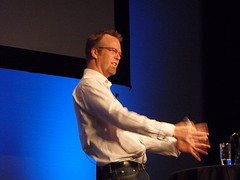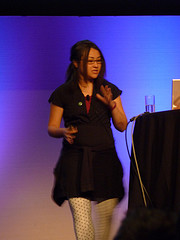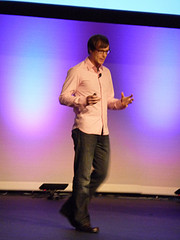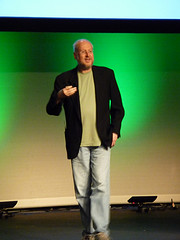Day 2 was brilliant straight off the bat. Apparently, Jeff Veen gave a very good presentation at the 2005 conference, which unfortunately was before my conference-going time.
 Jeff Veen is truly a brilliant speaker, and having been involved in designing tools such as Blogger, TypePad, Flickr and Google Analytics, he knows his stuff. Now, we all love LOLCATS, the dramatic hamster and being Rick-rolled, but Jeff brings a lot of humour and entertainment to his presentations without resorting to funny Google image search results or tired internet memes. Data can be pretty boring, but by assigning different aspects of data to different design elements to help tell the story of the information. He used an example to show how boring rainfall data can be made into info-graphics quite easily. Remove anything that does not help tell the story. The take-home message was to let go of control, allowing the user to view your content in the way that suits them. Design tools to let them have their own experience. It's super-important to know yourself first, then understand your users. The best ideas are those that come from a passion.
Jeff Veen is truly a brilliant speaker, and having been involved in designing tools such as Blogger, TypePad, Flickr and Google Analytics, he knows his stuff. Now, we all love LOLCATS, the dramatic hamster and being Rick-rolled, but Jeff brings a lot of humour and entertainment to his presentations without resorting to funny Google image search results or tired internet memes. Data can be pretty boring, but by assigning different aspects of data to different design elements to help tell the story of the information. He used an example to show how boring rainfall data can be made into info-graphics quite easily. Remove anything that does not help tell the story. The take-home message was to let go of control, allowing the user to view your content in the way that suits them. Design tools to let them have their own experience. It's super-important to know yourself first, then understand your users. The best ideas are those that come from a passion.
 Unfortunately, I didn't learn much from this session as I thought I might. I think I was expecting it to be more about coming up with inspiration for cool design elements and applying CSS to make it all happen. I love Jina's designs, so it would have been good to see how her mind works when creating a new masterpiece, but her session was still quite entertaining. Jina opened with the rule of "Write it clean. Keep it clean". I often fall into this trap of allowing my style sheets to get unruly over time. Later down the road when a redesign comes along, it gets harder to fix it all up later. Comments in your CSS are your friend such as comments at the top of the file defining the website's colour scheme; a technique I already use. Separate your CSS sections with flags (a comment that begin with an = or something) and add a list of them in a comment block at the top to use as an index. This would help when working on larger sites or when working as part of a team. A good idea is to add a simple comment note to show when styles have been redefined in another CSS file, such as an IE6-specific stylesheet. Jina also talked about some CSS3 coolness such as multiple background images, border images, columns and grid positioning, but this was mostly stuff better explained by Andy Clarke at WDS07. Still, it was great to finally meet Jina, as I'd been following her blog for a while now.
Unfortunately, I didn't learn much from this session as I thought I might. I think I was expecting it to be more about coming up with inspiration for cool design elements and applying CSS to make it all happen. I love Jina's designs, so it would have been good to see how her mind works when creating a new masterpiece, but her session was still quite entertaining. Jina opened with the rule of "Write it clean. Keep it clean". I often fall into this trap of allowing my style sheets to get unruly over time. Later down the road when a redesign comes along, it gets harder to fix it all up later. Comments in your CSS are your friend such as comments at the top of the file defining the website's colour scheme; a technique I already use. Separate your CSS sections with flags (a comment that begin with an = or something) and add a list of them in a comment block at the top to use as an index. This would help when working on larger sites or when working as part of a team. A good idea is to add a simple comment note to show when styles have been redefined in another CSS file, such as an IE6-specific stylesheet. Jina also talked about some CSS3 coolness such as multiple background images, border images, columns and grid positioning, but this was mostly stuff better explained by Andy Clarke at WDS07. Still, it was great to finally meet Jina, as I'd been following her blog for a while now.
 As part of the LGSA and the Local Government Web Network in NSW, Diana's session related very closely to my day-to-day as she told the story of how when she started working in Local Government, so had to tie up all the loose bits and pieces on the various websites into a streamlined CMS solution, but over time, as stake-holders wanted more out of their websites, and as the CMS gets stretched to its limits, she started looking into some custom-built solutions. Generally stretching the limits of your CMS is a bad idea, so investing in custom solutions can allow you a much more exciting approach as it allows you to build what you want, learn new techniques and generally not be limited by the confines of a CMS. This also enables you to enhance the end-user experience beyond the capabilities of your CMS. Finding the right balance is important.
As part of the LGSA and the Local Government Web Network in NSW, Diana's session related very closely to my day-to-day as she told the story of how when she started working in Local Government, so had to tie up all the loose bits and pieces on the various websites into a streamlined CMS solution, but over time, as stake-holders wanted more out of their websites, and as the CMS gets stretched to its limits, she started looking into some custom-built solutions. Generally stretching the limits of your CMS is a bad idea, so investing in custom solutions can allow you a much more exciting approach as it allows you to build what you want, learn new techniques and generally not be limited by the confines of a CMS. This also enables you to enhance the end-user experience beyond the capabilities of your CMS. Finding the right balance is important.
 Daniel Burka is the Creative Director of Digg, and the co-founder of Pownce. Daniel highlighted the need to improve your website over time to prevent it from stagnating. Handling feedback is important: what do people want and why do they want it? Don't worry about your website getting too big too fast, because having to adapt to scale is a GREAT problem to have. Also, don't worry about building the most sophisticated system out of the gate. Get it out there and add to it as ne needs are identified. Also removing stuff is iteration too. Try to remove as much as you add. Cameron Moll is a clever dude - Realign, don't redesign. The Digg commenting system have been changed many times. Digg users love to complain but this should be listened to. Although a comment may be buried, people still click them. They love the shitty comments. The ideal process goes something like:
Daniel Burka is the Creative Director of Digg, and the co-founder of Pownce. Daniel highlighted the need to improve your website over time to prevent it from stagnating. Handling feedback is important: what do people want and why do they want it? Don't worry about your website getting too big too fast, because having to adapt to scale is a GREAT problem to have. Also, don't worry about building the most sophisticated system out of the gate. Get it out there and add to it as ne needs are identified. Also removing stuff is iteration too. Try to remove as much as you add. Cameron Moll is a clever dude - Realign, don't redesign. The Digg commenting system have been changed many times. Digg users love to complain but this should be listened to. Although a comment may be buried, people still click them. They love the shitty comments. The ideal process goes something like:
Having done this, set new goals, avoiding feature creep. Add most requested functionality. Perform task analysis, user testing. Don't set a public timeline for this. Just try to get it perfect and include everything people wanted, then launch it and start the loop again.
 Software is not subject to Moore's Law. It is subject to Murphy's Law. Productivity software doubles every 20 years rather than 2 years. Javascript is the ideal mash-up language, but due to the browser security model, the web is under attack. It was not designed to be doing any of the things we're using it for now. It is inherently insecure. The consequences of an attack are horrible, such as loss of trust or money. Doug went over a lot of this during our workshop on Wednesday.
Software is not subject to Moore's Law. It is subject to Murphy's Law. Productivity software doubles every 20 years rather than 2 years. Javascript is the ideal mash-up language, but due to the browser security model, the web is under attack. It was not designed to be doing any of the things we're using it for now. It is inherently insecure. The consequences of an attack are horrible, such as loss of trust or money. Doug went over a lot of this during our workshop on Wednesday.
As with last year, I didn't take notes from Mark’s brilliant-as-always closing keynote. It’s just too damn hard to take meaningful notes while at the same time trying to take it all in. I suggest you try and find it on YouTube or something, because it was fantastic. Sadly, this was Marks final closing keynote at Web Directions (for a few years at least) to allow him to attend the conference not as a geek-uber-god, but instead as one of us regular, unwashed masses. Good luck with that, Mark. :) Anyway, it will be interesting to see who John and Maxine replace him with for next year’s closing keynote.
Comments on this post have been closed. If you would like to contact me about this post or for any reason, please get in touch.
23 October, 2008 at 12:34 pm
Nice article. Thanks. :) Eugene